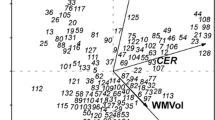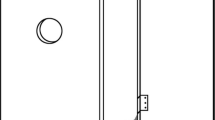Abstract
Many beetles associated with old trees are on national red lists, but pseudoscorpions living in similar habitats have received little attention. This study reports the habitat and occurrence patterns of two species of pseudoscorpions living in hollow trees. Their occurrence has been assessed by sieving wood mould from 274 oaks in southeastern Sweden and from museum specimens collected in Sweden. Larca lata is confined to hollow oaks with a large girth and a plentiful supply of wood mould. Allochernes wideri is much less particular about wood mould volume, trunk diameter and tree species. Larca lata inhabits hollow trunks with characteristics that are typical of very old trees, whereas A. wideri predominantly occurs in trunks in an earlier stage of hollow formation. Larca lata was almost exclusively found in larger assemblages of hollow oaks, which suggests long-term survival may be difficult when the network of suitable hollow trees is too sparse. Larca lata is a rare species in Europe and probably vulnerable to extinction, since it is dependent on a habitat which has declined severely in the last few centuries.
Similar content being viewed by others
References
Aguiar, N.O. and Bürnheim, P.F. (1998) Phoretic pseudoscorpions associated with flying insects in Brazilian Amazônia. J. Arachnol. 26, 452-9.
Alexander, K.N.A. (1998) The links between forest history and biodiversity: the invertebrate fauna of ancient pasture-woodlands in Britain and its conservation. In The ecological history of European forests. (K.J. Kirby and C. Watkins, eds) pp. 73-80. CAB International, Oxon.
Anonymous (1749) Östergötlands landskanslis arkiv. EIII:1 förteckning över tillgången av ekar i Östergötland (Handwritten in Swedish. Available at Government Archives in Vadstena.)
Beier, M. (1970) Reliktformen in der Pseudoscorpioniden-Fauna Europas. Memorie Soc. ent. ital. 48, 317-23.
Beier, M. (1977) —Pseudoskorpione aus Kashmir und Ladakh (Arachnida). Senckenbergiana biol. 58, 415-7.
Drogla, R. (1977) Zur Pseudoscorpion-Fauna des Naturschutzgebietes 'Tiefental'. Veröff d. Museums d. Westlausitz Kamenz 1, 87-90.
Drogla, R. and Blick, T. (1996) Rote Liste der Pseudoskorpione Deutschlands (Arachnida: Pseudoscorpiones). Arachnol. Mitt. 11, 36-8.
Drogla, R. and Lippold, K. (1994) Neunachweise von Pseudoskorpionen in den neuen Bundesl¨andern Deutschlands (Arachnida, Pseudoscorpiones). Arachnol. Mitt. 8, 75-6.
Duchác, V. (1993a) Zwei neue Afterskorpion-Arten aus der Tschechischen Republik. Arachnol. Mitt. 5, 36-8.
Duchác, V. (1993b) Stírci (Pseudoscorpionidea) ze stromovych dutin na Trebonsku. Sbor. Jihoces. Muz. v. Ces. Budejovicich Prúr. Vedy 33, 65-9 (in Czech, German summary).
Dumitresco, M. and Orghidan, T. (1964) Contribution à la connaissance des Pseudoscorpions de la Dobroudja. 1re note. Annls Spéléol. 19, 599-630.
Ehnström, B., Gärdenfors, U. and Lindelöw, Å. (1993) Rödlistade evertebrater i Sverige 1993. Uppsala: Databanken f ör hotade arter (Swedish Red List of Invertebrates 1993. In Swedish, English abstr.).
Gärdenfors, U. and Wilander, P. (1995) Ecology and phoretic habits of Anthrenochernes stellae (Pseudoscorpionida, Chernetidae). Bull. Br. arachnol. Soc. 10, 28-30.
Gärdenfors, U. and Wilander, P. (1992) Sveriges keokrypare med nyckel till arterna. Entomol. Tidskr. 113, 20-35 (Swedish pseudoscorpions with a key to the species. In Swedish, English abstr.).
Hannah, L., Carr, J.L. and Lankerani, A. (1995) Human disturbance and natural habitat: a biome level analysis of a global data set. Biodivers. Conserv. 2, 128-55.
Hanski, I., Moilanen, A. and Gyllenberg, M. (1996) Minimum viable metapopulation size. Am. Nat. 147, 527-41.
Harding, P.T. and Rose, F. (1986) Pasture-woodlands in lowland Britain. A review of their importance for wildlife conservation. Institute of Terrestrial Ecology, Huntingdon.
Harvey, M.S. (1991) Catalogue of the Pseudoscorpionida. Manchester University Press, Manchester.
Hosmer, D.W. and Lemeshow, S. (1989) Applied logistic regression. John Wiley and Sons, New York.
Jedryczkowski, B.W. (1987) Zaleszczotki (Pseudoscorpiones) Gór Swietokrzyskich. Fragm. faun. (Warszawa) 31, 135-57 (In Polish, English abstr.).
Judson, M.L.I. and Legg, G. (1996) Discovery of the pseudoscorpion Larca lata (Garypoidea, Larcidae) in Britain. Bull. Br. arachnol. Soc. 10, 205-10.
Kelner-Pillault, S. (1974) Étude écologique du peuplement entomologique des terraux d'arbres creux (chataigners et saules). Bull. Ecol. 5, 123-56.
Kirby, K.J., Thomas, R.C., Key, R.S. and McLean, I.F.G. (1995) Pasture-woodland and its conservation in Britain. Biol. J. Linn. Soc. (Suppl.) 56, 135-53.
Kirby, K.J. and Watkins, C. (1998) (eds) The ecological history of European forests. CAB International, Oxon.
Levins, R. (1969) Some demographic and genetic consequences of environmental heterogeneity for biological control. Bull. Entomol. Soc. Am. 15, 237-40.
Lewis, O.T., Thomas, C.D., Hill, J.K., Brookes, M.I., Robin Crane, T.P., Graneau, Y.A., Mallet, J.L.B. and Rose, O.C. (1997) Three ways of assessing metapopulation structure in the butterfly Plebejus argus. Ecological Entomology 22, 283-93.
Luce, J.M. (1996) Osmoderma eremita (Scopoli, 1763). In Background information on invertebrates of the Habitats Directive and the Bern Convention. Part 1: Crustacea, Coleoptera and Lepidoptera: (P.J. van Helsdingen, L. Willemse and M.C.D. Speight, eds), pp 64-9. Council of Europe, Strasbourg.
Lundblad, O. (1950) Studier över insektsfaunan i Fiby urskog. Stockholm: Kungliga Svenska Vetenskapsakademien (in Swedish).
McLean, I.F.G. and Speight, M.C.D. (1993) Saproxylic invertebrates-the European context. In Dead wood matters: the ecology and conservation of saproxylic invertebrates in Britain (K.J. Kirby and C.M. Drake, eds), pp. 21-32. English Nature Science No. 7.
Meinertz, N.T. (1962) Danmarks Fauna Bd 67. Mosskorpioner og mejere (Pseudoscorpionidea og Opiliones). København: G E C Gads Forlag (in Danish).
Nilsson, S.G. (1997) Forests in the temperate-boreal transition: natural and man-made features. Ecol. Bull. 46, 61-71.
Nilsson, S.G. and Baranowski, R. (1994) Indikatorer på jättetr ädskontinuitet-svenska f örekomster av knäppare som är beroende av grova, levande träd. Entomol. Tidskr. 115, 81-97 (Indicators of megatree continuity-Swedish distribution of click beetles (Coleoptera, Elateridae) dependent on hollow trees. In Swedish, English abstr.).
Nilsson, S.G. and Baranowski, R. (1997) Habitat predictability and the occurrence of wood beetles in old-growth beech forests. Ecography 20, 491-8.
Palm, T. (1959) Die Holz-und Rinden-käfer der süd-und mittelschwedischen Laubbäume. Opusc. Entomol. Suppl. XVI.
Rafalski, J. (1953) Fauna pajeczaków. Parku Narodowego na wyspie Wolinie swietle dotychczasowych badán. Ochr. Przyr. 21, 217-48. (In Polish).
Ranius, T. (2000) Minimum metapopulation size of a beetle, Osmoderma eremita, living in tree hollows. Anim. Cons. 3, 00-00. In press.
Ranius, T. and Nilsson, S.G. (1997) Habitat of Osmoderma eremita Scop. (Coleoptera: Scarabaeidae), a beetle living in hollow trees. J. Insect Cons. 1, 193-204.
Ressl, F. (1965) Ñber Verbreitung, Variabilität und Lebensweise einiger österreichischer Afterskorpione. Dt. ent. Z. 12, 289-95.
Schenkel, E. (1928) Pseudoscorpionida (Afterskorpione). In Die Tierwelt Deutschlands 8. Teil. Spinnentiere oder Arachnoidea III. (F. Dahl, ed) Jena: Verlag von Gustav Fischer.
Speight, M.C.D. (1989) Saproxylic invertebrates and their conservation. Council of Europe, Strasbourg.
Vachon, M. (1940) Remarques sur la phoresie des pseudoscorpions. Ann. Soc. ent. France 109, 1-18.
Zeh, D.W. and Zeh, J.A. (1992) Emergence of a giant fly triggers phoretic dispersal in the neotropical pseudoscorpion, Semeiochernes armiger (Balzan) (Pseudoscorpionida: Chernetidae). Bull. Br. arachnol. Soc. 9, 43-46.
Author information
Authors and Affiliations
Rights and permissions
About this article
Cite this article
Ranius, T., Wilander, P. Occurrence of Larca lata H.J. Hansen (Pseudoscorpionida: Garypidae) and Allochernes wideri C.L. Koch (Pseudoscorpionida: Chernetidae) in tree hollows in relation to habitat quality and density. Journal of Insect Conservation 4, 23–31 (2000). https://doi.org/10.1023/A:1009682722905
Issue Date:
DOI: https://doi.org/10.1023/A:1009682722905




